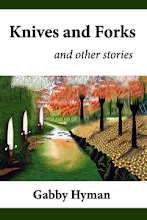
"...after the people are dead, after the things are broken and scattered, the smell and taste of things remain poised a long time, like souls· bearing resiliently, on tiny and almost impalpable drops of their essence...." -- Marcel Proust
Neurobiologists say that we have more than 1,000 different sensors inside our nose, located at eye level, enabling us to identify more than 10,000 distinct odors. Since the cells in the nose are short-lived and frequently replaced, the researchers claim that olfactory codes must be mapped in the brain to enable us to associate the smells with phenomena. Then the brain attaches linguistic information so that we have words for them. The catalog can be extensive. Wine aficionados probably have a broader memory vocabulary than I have for crushed grapes. While the associations seem instantaneous, they have taken a lifetime to form, and we probably inherit genetic memory from ages ago when we had to sort out meat and berries for spoilage.
My favorite earliest memory is of honeysuckle hedges along the walkways of a motel in San Diego. I would set the date around 1963. Whenever I pass a row of honeysuckle today, I am instantly in front of the Mission Valley Inn, and then I wander the broad highway of associations with lobster, which we ate by the harborside, and an evening's walk in the crisp salt air. My first sweetheart wore a lily of the valley perfume and whenever I smell something in that broad palate of odors, I am transported instantly into her arms.
In the spring of 1979 I met Maki Yamada , a woman from Nagoya, Japan. She had arrived in California to study English -- and to learn how to drive a car. Driving school was prohibitively expensive in Japan. After several months we moved in together, taking a small cottage just a block from the beach in Santa Cruz. You could smell eucalyptus trees out the window and hear the morning waves. In those days, my attire of choice was a pair of overalls, a railroad engineer's cap, and bare feet. It was the beach, after all.
Maki adored the cap, which she would swipe from my head, hold to her nose, take a long sniff, and sigh.
"Ee-nyoi," she'd say.
It was as if the cap was a portal to her baby blanket, or some ancient connection to paradise. As often as she did it, I could never see it coming. She'd whip the cap off my head and bury her nose in it.
"Ee-nyoi."
I'd ask her what a smelly old hat had to do with anything and she would just sigh and lift it back to her nose. It had no particular odor I could discern. Perhaps it lay camouflaged in the blank spot of familiarity, just like the smells of our house that only visitors can sense.
Teaching Maki-san to drive was a challenge. We had to overcome linguistic barriers and the illogical machinations of clutch and stick. "Put the clutch in where!" she stammered as the VW lurched and died.
At the end of her stay in America, I took Maki-san to the San Francisco Airport, hoping I'd be invited to join her back in Nagoya when she settled. No such fortune. I was heartbroken and sent her tape recordings of the waves rushing against the sand at the beach. The cap had finally deteriorated and I put what was left of it in a mailbag and sent it, too.
She eventually married a German doctor and raised a family on the coast of Australia. In the photos, the children look hale and inquisitive.
Do you think that associations can morph over time? One of my fondest memories of my extended tour of Japan was the smell of rice fields when farmers burned the husks after harvest. It reminded me of the smell of wild dormitory parties at San Jose State in the early 70s.
Today, whenever I smell a burning campfire, it reminds me of the scent of smoldering paddies, and that, of course, makes me think instantly of Japan, and instantly of Maki Yamada... and then I see my hat as good as new.




















No comments:
Post a Comment